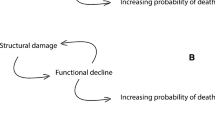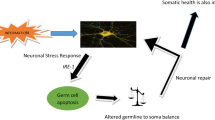Abstract
A great deal of progress has recently been made in characterizing the “mechanisms of aging.” A comparison with the mechanisms of development shows that the two sets of mechanisms are different; nevertheless, mechanisms of aging are conditioned by what happens during development. Aging and development also share some characteristics, such as a similar difficulty in attributing a precise temporal boundary to these processes. Other characteristics seem more specific to aging, such as the role of external (to the organism) and stochastic events in its progression. In fact, both development and aging are historical processes with a mixture of stochastic events and deterministic processes, the ratio of the two being different in each process. Therefore, it is concluded that aging does not fit with a broad, lifelong conception of development.
Similar content being viewed by others
References
Bateson P, Barker D, Clutton-Brock T, Deb D, D’Udine B et al (2004) Developmental plasticity and human health. Nature 430:419–421
Blasco MA (2007) Telomere length, stem cells and aging. Nat Chem Biol 10:640–647
Borges RM (2009) Phenotypic plasticity and longevity in plants and animals: cause and effect? J Biosci 34:605–611
Brunet A, Rando TA (2007) From stem to stern. Nature 449:288–290
Burtner CR, Kennedy BK (2010) Progeria syndromes and ageing: what is the connection? Nat Rev Mol Cell Biol 11:567–578
Chen J-H, Martin-Gronert MS, Tarry-Adkins J, Ozanne SE (2009) Maternal protein restriction affects postnatal growth and the expression of key proteins involved in lifespan regulation in mice. PLoS ONE 4(3):e4950
Cohen E, Paulsson JF, Blinder P, Burstyn-Cohen T, Du D et al (2009) Reduced IGF-1 signaling delays age-associated proteotoxicity in mice. Cell 139:1157–1169
Fernandez-Capetillo O (2010) Intrauterine programming of ageing. EMBO Rep 11:32–36
Finkel T, Serrano M, Blasco MA (2007) The common biology of cancer and ageing. Nature 448:767–774
Fontana L, Partridge L, Longo VD (2010) Extending healthy life span—from yeast to humans. Science 328:321–326
Fraga MF, Esteller M (2007) Epigenetics and ageing: the targets and the marks. Trends Genet 23:413–418
Gilbert SF (2011) Expanding the temporal dimensions of developmental biology: the role of environmental agents in establishing adult-onset phenotypes. Biol Theory. doi:10.1007/s13752-011-0008-0
Guarente L (2003) Ageless quest. Cold Spring Harbor Laboratory Press, Cold Spring Harbor
Heijmans BT, Tobi EW, Stein AD, Putter H, Blauw GJ et al (2008) Persistent epigenetic differences associated with prenatal exposure to famine in humans. Proc Natl Acad Sci USA 105:17046–17049
Herndon LA, Schmeissner PJ, Dudaronek JM, Brown PA, Listner KM et al (2002) Stochastic and genetic factors influence tissue-specific decline in ageing C. elegans. Nature 419:808–814
Hooten NN, Abdelmohsen K, Gorospe M, Ejiogu N, Zonderman AB, Evans MK (2010) microRNA expression patterns reveal differential expression of target genes with age. PLoS one 5:e10724
Jacob F (1973) The logic of life: a history of heredity. Princeton University Press, Princeton
Jaskellioff M, Muller FL, Paik J-H, Thomas E, Jiang S et al (2011) Telomerase reactivation reverses tissue degeneration in aged telomerase-deficient mice. Nature 469:102–106
Kenyon CJ (2010) The genetics of ageing. Nature 464:504–512
Kirkwood TBL, Austad SN (2000) Why do we age? Nature 408:233–238
Kirkwood TBL, Rose MR (1991) Evolution of senescence: late survival sacrificed for reproduction. Phil Trans R Soc Lond Ser B 332:15–24
Lazarov O, Mattson MP, Peterson DA, Pimplikar SW, van Praag H (2010) When neurogenesis encounters aging and disease. Trends Neurosci 33:569–579
Lee H-W, Blasco MA, Gottlieb GJ, Horner JW II, Greider CW, DePinho RA (1998) Essential role of mouse telomerase in highly proliferative organs. Nature 392:569–574
Levi BP, Morrison SJ (2008) Stem cells use distinct self-renewal programs at different ages. Cold Spring Harbor Symp Quant Biol 73:539–553
Lindner AB, Demarez A (2009) Protein aggregation as a paradigm of ageing. Biochimimica et Biophysica Acta 1790:980–996
Lithgow GJ, White TM, Melov S, Johnson TE (1995) Thermotolerance and extended life-span conferred by single-gene mutations and induced by thermal stress. Proc Natl Acad Sci USA 92:7540–7544
Lu T, Pan Y, Kao S-Y, Li C, Kohane I et al (2004) Gene regulation and DNA damage in the ageing human brain. Nature 429:883–891
Mather KA, Jorm AF, Parslow RA, Christensen H (2011) Is telomere length a biomarker of aging? A review. J Gerontol Ser A 66:202–213
Medawar PB (1952) An unsolved problem of biology. Lewis, London
Mentis A-FA, Kararizou E (2010) Does ageing originate in utero? Biogerontology 11:725–729
Murga M, Bunting S, Montana MF, Soria R, Mulero F et al (2009) A mouse model of ATR-Seckel shows embryonic replicative stress and accelerated aging. Nat Genet 41:891–899
Nicoglou A (2011) Defining the boundaries of development with plasticity. Biol Theory. doi:10.1007/s13752-011-0003-5
Nikolaev A, McLaughlin T, O’Leary DDM, Tessier-Lavigne M (2009) APP binds DR6 to trigger axon pruning and neuron death via distinct caspases. Nature 457:981–990
Oyama S, Griffiths PE, Gray RD (2001) Cycles of contingency: developmental systems and evolution. MIT Press, Cambridge, MA
Rando TA (2006) Stem cells, ageing and the quest for immortality. Nature 441:1080–1085
Rossi DJ, Bryder D, Seita J, Nussenzweig A, Hoeijmakers J, Weissman IL (2007) Deficiencies in DNA damage repair limit the function of haematopoietic stem cells with age. Nature 447:725–729
Rossi DJ, Jamieson CHM, Weissman IL (2008) Stems cells and the pathways to aging and cancer. Cell 132:681–696
Sahin E, DePinho RA (2010) Linking functional decline of telomeres, mitochondria and stem cells during ageing. Nature 464:520–528
Sahin E, Colla S, Liesa M, Moslehl J, Müller FL et al (2011) Telomere dysfunction induces metabolic and mitochondrial compromise. Nature 470:359–365
Sharpless NE, DePinho RA (2007) How stem cells age and why this makes us grow old. Nat Rev Mol Cell Biol 8:703–713
Théry F (2011) Characterizing animal development with genetic regulatory mechanisms. Biol Theory. doi:10.1007/s13752-011-0004-4
Vijg J, Campisi J (2008) Puzzles, promises and a cure of ageing. Nature 454:1065–1071
Williams GC (1957) Pleiotropy, natural selection, and the evolution of senescence. Evolution 11:398–411
Yu CE, Oshima J, Fu YH, Wijsman EM, Hisama F et al (1996) Positional cloning of the Werner’s syndrome gene. Science 272:258–262
Zernicka-Goetz M, Huang S (2010) Stochasticity versus determinism in development: a false dichotomy? Nat Rev Genet 11:743–744
Acknowledgments
I am indebted to Lucie Laplane, Francesca Merlin, Antonine Nicoglou, Thomas Pradeu, Frédérique Théry, and Michel Vervoort for helpful discussions, and to David Marsh for critical reading of the manuscript.
Author information
Authors and Affiliations
Corresponding author
Rights and permissions
About this article
Cite this article
Morange, M. Development and Aging. Biol Theory 6, 59–64 (2011). https://doi.org/10.1007/s13752-011-0010-6
Received:
Accepted:
Published:
Issue Date:
DOI: https://doi.org/10.1007/s13752-011-0010-6




